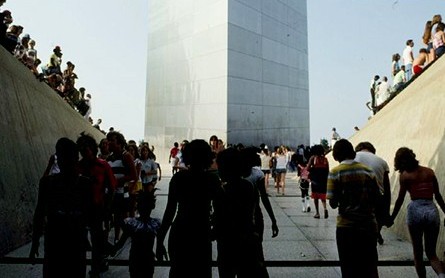The Location
The old St. Louis Riverfront was selected in 1935 as the site of the Jefferson National Memorial, which commemorates the westward expansion of the United States in the 19th century, as envisioned by Thomas Jefferson. The Memorial includes the Arch and an underground visitor's center directly beneath it. This center contains the Museum of Westward Expansion, which tells the century-long story of the opening of the West in the 1800s.
Construction
|

|
In 1947 the Jefferson National Expansion Memorial Association, a group of public-spirited citizens, held a nationwide competition to obtain an appropriate design. The winner of the competition was Eero Saarinen, and he had the perfect idea.
Magnificent in its concept, majestic in its setting, unique in its execution, the Gateway Arch towers above the banks of the Mississippi River. It is the iconic centerpiece of the $30 million Jefferson National Expansion Memorial, and it provided many engineering firsts for the US right here in St. Louis.
Historic Eads Bridge, for example, was the first tubular steel arch structure of its kind. Completed in 1874, this bridge forms the northern boundary of the memorial. At the southern boundary stands the steel plate girder bridge designed by Sverdrup and Parcel—the first US bridge of its size to use orthotropic design.
The Arch itself, in neighborly spirit, borrows its concept from Captain Eads to make use of the stress analysis and structural design used by Sverdrup and Parcel. The stainless-steel-faced Arch spans 630 feet between the outer faces of its triangular legs at the ground level, and its top soars 630 feet into the sky. It takes the shape of an inverted catenary curve, a shape such as would be formed by a heavy chain hanging freely between two supports.
Each leg is an equilateral triangle with sides that are 54 feet long at ground level, tapering to 17 feet at the top. The legs have double walls of steel 3 feet apart at ground level and 7-3/4 inches apart above the 400-foot mark. Up to the 300-foot mark, the space between the walls is filled with reinforced concrete. Beyond that point, steel stiffeners are used.
The double-walled, triangular sections were placed one on top of another and then welded inside and out to build the legs of the Arch. Sections ranged in height from 12 feet at the base to 8 feet for the two keystone sections. The complex engineering design and construction is completely hidden from view. All that can be seen is the sparkling stainless steel outside and the inner skin of carbon steel, which combine to carry the gravity and wind loads to the ground. The Arch has no real structural skeleton, as its inner and outer steel skins, joined to form a composite structure, give it its strength and permanence.
Entrance to the Arch is from the underground George B. Hartzog, Jr. Visitor Center. Visitors are carried from the lobby level below to the observation platform at the top of the Arch by a unique conveyance system: a 40-passenger train made up of eight five-passenger capsules in each leg. Operating at the rate of 340 feet per min., the ride takes 10 minutes round trip.
The observation platform is 65 feet by 7 feet, with plate-glass windows providing a view of the east and west. There is also a conventional maintenance elevator in each leg as far as the 372-foot level, and stairways with 1,076 steps in each leg rise from the base to the top of the Arch. These elevators and stairways are for maintenance and emergency use only.
The Significance of the Arch Grounds
The landscape around the Arch reflects the curvilinear nature of the structure. Landscape architect Dan Kiley applied geometrical precepts and classical landscape design elements to create a setting that is both spectacular and subtly appropriate. The scale, impact, and design of the grounds constitute an essential mooring for the world-famous Arch, with one reflecting the other.
The memorial is a comprehensive work that melds landscape with sculpture. The Gateway Arch cannot be separated from the landscape, as together they represent a cohesive artistic endeavor. The physical components that establish the importance of the landscape include:
- Spatial Organization - This includes the axial relationship between the Arch and the Old Courthouse. It can also be seen in the contrast between the open space beneath the Arch and the enclosed canopy of trees along the north-south walkways, along with the scattering of canopy trees over the open lawn around the ponds.
- Topography - The land is level under the Arch before it slopes down in undulating waves to the ponds. It then ramps back up to the berm along the edge of Memorial Drive. The design recessed the expressway to minimize the noise and the physical and visual intrusion that would be imposed by an at-grade highway.
- Surrounding Structures - There are many buildings and structures that Saarinen wanted to complement the Gateway Arch. These include the Old Courthouse, the underground museum, and the overlooks and railroad tunnels to the north and south.
- Vegetation - The area's vegetation is largely defined by the Rosehill Ash monoculture that dominates the walks leading to the Arch. There are also Bald Cypress circles, plantings around the north and south ponds, and several trees and shrubs planted around service areas.
- Circulation Networks - The circulation network at the memorial site is centered on a convenient parking garage for visitors. Naturally, there are also plenty of sidewalks and walking space leading to the Arch and connecting the Arch to the city.